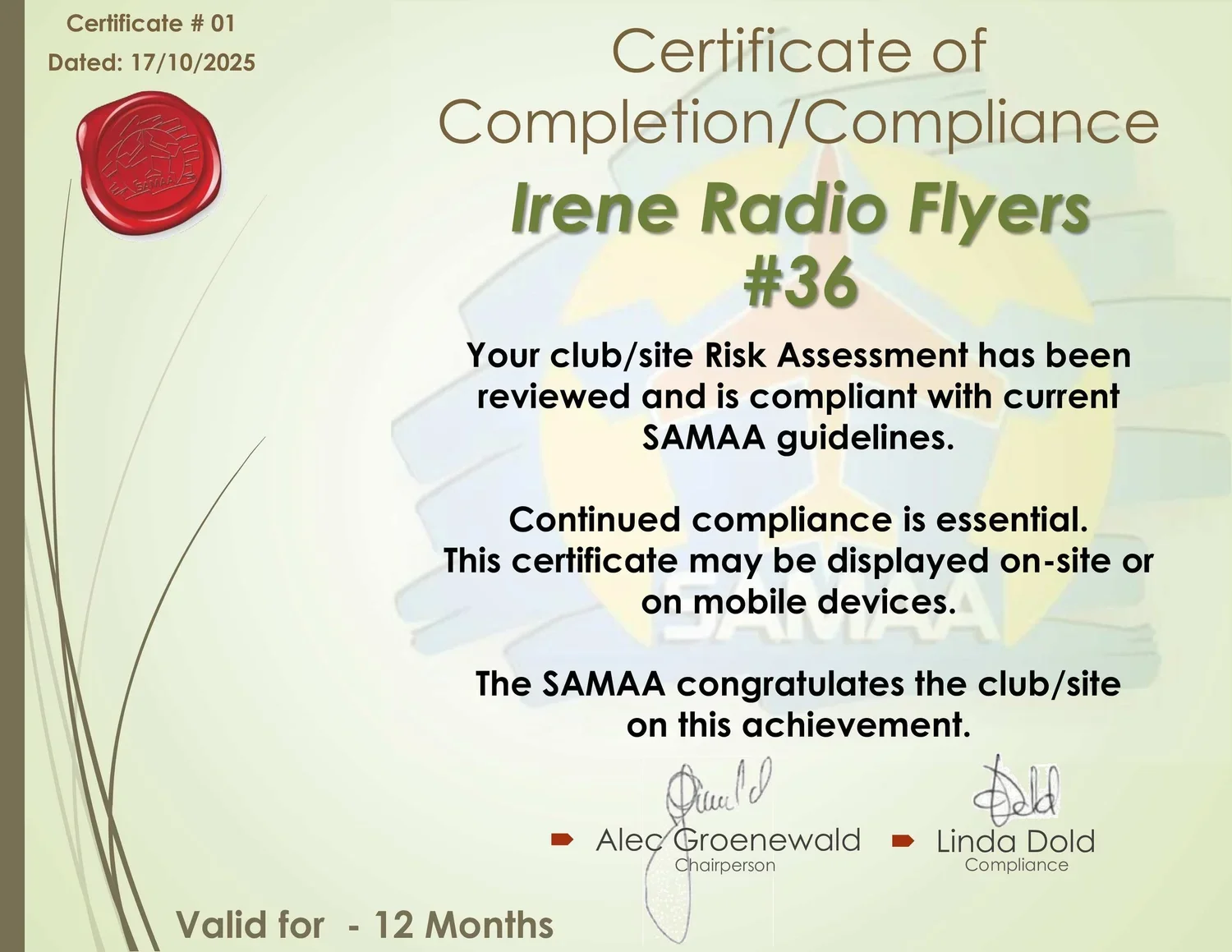SAMAA ARO Approval Certificate 2025
CERTIFICATE OF COMPLETION
SAMAA MOP (MANUAL OF PROCEDURE)
This article explains the dangers of allowing non-SAMAA members to fly at SAMAA-registered clubs or sites.
It is of concern, and a known fact that there are model fliers without SAMAA membership using the facilities of registered SAMAA clubs, or sites, sometimes with the knowledge and even consent of the club’s management! The SAMAA (read, Management Committee, since all of us are really SAMAA) is not an enforcement agency, and the management committee has neither the capacity nor the desire to play policeman. It is however expected that clubs and club managements will self-manage their activities, and do the right thing to ensure that fliers using the club's facilities for flying of their model aircraft, are adequately protected, and this means that all flying members must be paid up SAMAA members.
We often get enquiries and comments at the office by members whose SAMAA membership has lapsed, and they claim that they were unaware of this. The SAMAA membership card is, in effect, your license to operate a model aircraft, and the expiry date of membership is clearly indicated. It is not unlike a driver’s license, or a motor vehicle license.
The real danger of allowing non-SAMAA members to fly from a registered SAMAA site or club, is something that must please receive consideration, no, attention. One can start by using an example of a non-SAMAA member having an accident at the club, let's say, with personal injury and property damage as a result. “So I don't have SAMAA membership, and it so happens that I do not have any form of public liability insurance. Sue me if you want”.
The party suffering injury, or property damage is now left without recourse, unless he chooses to follow an expensive and time-consuming legal course of action, sometimes with no guarantee of a successful outcome. A likely scenario is that a lawyer or advocate may decide to include the club management, and even the members, in this action, reasoning that the club officers knowingly allowed a non-SAMAA member to use the club's facilities, thereby increasing the risk profile. Landowners could also suffer consequences, since the incident happened on their property.
One can draw an analogy here: would you allow an unlicensed driver to use your motor vehicle, and risk having it damaged or even written off, with no recourse? Let's not even contemplate loss of life where a third party may have been involved. In a case like this, if you gave your permission for the use of your vehicle by an unlicensed driver, you may face arrest and prosecution on criminal charges.
Please note that all the SAMAA registered clubs and sites, have allocated airspace above and around the site, and the details of the clubs and sites appear in the National Airspace Register. The SAMAA is the responsible entity, and it carries the responsibility and liability to manage this airspace. It is only logical that only SAMAA members are entitled to use this airspace. In the event of proven cases where clubs continue to turn a blind eye of non-members using the site, the SAMAA Management Committee will be left with no alternative but to consider de-registration, after due process of course, and to inform all relevant authorities, and landowners.
Sites that are not managed by traditional club structures, are particularly at risk. Perhaps a good example is the slope soaring site at Volksrust (Tamatieberg). There is no club committee managing the activities at this site. Yes, visits and outings are generally pre-arranged, but everyone using the site could do well to make simple enquiries to establish that all the fliers in attendance, are paid-up SAMAA members.
There is however the accepted practice of “try-out” flights that may happen at clubs quite often. A bona-fide interested spectator or visitor is given a short introductory flight through a qualified instructor, with a view of joining the club and the SAMAA, and being taught to fly. In this case, the instructor is the owner of the equipment and accepts liability in case of an incident. The SAMAA insurance company will entertain a claim, should there have been an incident or accident.
This is a gentle reminder and a wake-up call to club managements: do not tempt fate by allowing fliers without valid SAMAA membership, to use your facilities for flying of model aircraft. The dangers and risks are just too great. Compliance is easy, and affordable, and the protection is beneficial to all of us in this great hobby.



